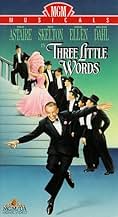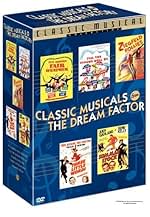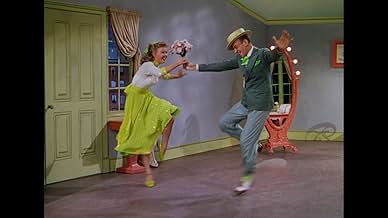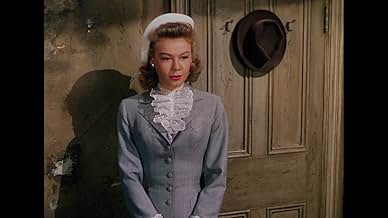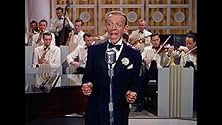NOTE IMDb
6,9/10
2,2 k
MA NOTE
Ajouter une intrigue dans votre langueThe story of the successful Tin Pan Alley songwriting team of Bert Kalmar and Harry Ruby is told loosely and lightheartedly.The story of the successful Tin Pan Alley songwriting team of Bert Kalmar and Harry Ruby is told loosely and lightheartedly.The story of the successful Tin Pan Alley songwriting team of Bert Kalmar and Harry Ruby is told loosely and lightheartedly.
- Réalisation
- Scénario
- Casting principal
- Nommé pour 1 Oscar
- 3 victoires et 3 nominations au total
Gloria DeHaven
- Mrs. Carter De Haven
- (as Gloria De Haven)
Harry Mendoza
- The Great Mendoza
- (as The Great Mendoza)
Jean Adcock
- Woman
- (non crédité)
Richard Allan
- Chorus Boy
- (non crédité)
William Bailey
- Man in Audience
- (non crédité)
Harry Barris
- Pianist at Party
- (non crédité)
Avis à la une
Although Astaire was a bit past his prime in the dancing area, this is by far the best acting performance he gave (Towering Inferno Oscar nod included). His Bert Kalmar is complex, restless, at times testy, and very much a real person compared to the standard Astaire character. Whether the circumstances depicted in the movie were fact or fiction, he is really a character with a distinct persona, as opposed to Fred Astaire essentially playing himself as in most other his other films.
After seeing all the overstuffed musical biographies which pay homage to Kern, Rodgers, Hart, Gershwin, and the like, this one is a breath of fresh air as it is much simpler and more basic in its construction. Its two main leads (Fred Astaire and Red Skelton) do not take the material over-the-top; instead they underplay, and in Skelton's case, he is so subdued that he reveals a wonderful, sensitive, acting talent. The musical numbers, of course ("Who's Sorry Now?" "Nevertheless," "Sunny Tennessee," "I Wanna Be Loved By You," "Three Little Words"), speak for themselves. And Astaire and Vera-Ellen are perfection on the dance floor- and no less than *three* times: in the tuxedoed duet "Where Did You Get That Girl?"; a tongue-in-cheek homage to dance domesticity- "Mr. & Mrs. Hoofer;" and the best moment- a tender, romantic adagio in an elaborate stateroom, "Thinking of You." There is also fine support from gorgeous redhead Arlene Dahl and spirited brunette Gloria DeHaven. And, of course, there is Debbie Reynolds (a full year before 'Singing In The Rain') performing as Helen Kane- with singing voice provided by Kane herself!!
This is my favorite of all Red Skelton's movies; he does a fine job as Ruby and his partnership with Kalmar, played by Fred Astaire who wrote many songs back in the 1920s and 30s. Of course, the music is grand and the dancing of Astaire and Vera-Ellen is most enjoyable. And the beautiful Arlene Dahl is the wife of Red. I thought she was more gorgeous than Rita Hayworth. Of particular note, a cute little blonde got her start in films as the voice of that Betty Boop girl, Helen Kane. She was Debbie Reynolds who sang "I Want to be Loved By You". Lots of the good old songs!
This was a wonderful, feel-good movie with tons of songs, many of them appealing. There also were some great dancing scenes, no surprise there since Fred Astaire is one of the stars. Astaire and Vera-Ellen paired up well for those numbers.
This is one of the few films, even in the musicals, in which all the characters were nice people. In other words, there were no villains, no nasty people, which is refreshing to see now and then. It is supposedly the true-life account of songwriters Bert Kalmar (Astaire) and Harry Ruby (Red Skelton). Ruby is good at writing tunes, but not with lyrics. Kalmar supplies the lyrics and dance. Skelton also shows he had a decent singing voice.
The only unhappy moments in the movie are the squabbles between the two leading men, but that's not overdone and sometimes it's humorous. Skelton's character is the nicer of the two.
The leading ladies are wholesome-looking beautiful women. Vera-Ellen is a Shirley Jones-type pretty blonde with a great dancer's body. She's enjoyable to watch. Arlene Dahl, who was stunning, is the other leading female but her role was minor, unfortunately.
The movie is a good mixture of song, dance, comedy and drama and is an underrated film in that it that doesn't get a lot of publicity. Astaire was quoted as saying this was his favorite film. I agree. It's my favorite of his, too.
This is one of the few films, even in the musicals, in which all the characters were nice people. In other words, there were no villains, no nasty people, which is refreshing to see now and then. It is supposedly the true-life account of songwriters Bert Kalmar (Astaire) and Harry Ruby (Red Skelton). Ruby is good at writing tunes, but not with lyrics. Kalmar supplies the lyrics and dance. Skelton also shows he had a decent singing voice.
The only unhappy moments in the movie are the squabbles between the two leading men, but that's not overdone and sometimes it's humorous. Skelton's character is the nicer of the two.
The leading ladies are wholesome-looking beautiful women. Vera-Ellen is a Shirley Jones-type pretty blonde with a great dancer's body. She's enjoyable to watch. Arlene Dahl, who was stunning, is the other leading female but her role was minor, unfortunately.
The movie is a good mixture of song, dance, comedy and drama and is an underrated film in that it that doesn't get a lot of publicity. Astaire was quoted as saying this was his favorite film. I agree. It's my favorite of his, too.
This film didn't try to do much more than bring us the songs. And that was good. It was wildly anachronistic -- the early number with Astaire and Vera Ella was danced to jazz that had to be some 15 or 20 years later than the date of the film, which at that point would be early 1920s, the age of the Turkey Trot, when bands were still coming out from their military origins. But the later sequence in the capacious ballroom of the ocean liner to "Thinking of You" was lovely. And the shot of the liner was the Normandie, wasn't it? Queen Mary was a four stacker. Vera Ella was a wonderfully acrobatic dancer. Al Schacht WAS a pitcher -- for 3 years (1919-21) for the Senators. The poster who said he was a catcher may have been thinking of Ray Schalk, a hall of fame catcher for the White Sox (including the 1919 nine, though not implicated in the throwing of the Series). And Barris, Rinker, and Bing sang with Paul Whiteman, not Duke Ellington. The MGM color in the 40s and 50s was magnificent -- and this film shows it off superbly. This one is a very enjoyable musical, one of the best of a period that produced some great ones.
Le saviez-vous
- AnecdotesBert Kalmar and Harry Ruby were friends of Fred Astaire from their early days together in vaudeville. Astaire said the film was one of his all-time favorites.
- GaffesThe stills of the The Marx Brothers (three rather than four) outside the opening of Animal Crackers (Broadway, 1928) is actually from Les Marx au grand magasin (1941).
- Citations
Bert Kalmar: I wouldn't write that song with you if you begged me.
Harry Ruby: Begged ya? I didn't even ask ya.
Bert Kalmar: I guess you just can't help it, Harry. I feel sorry for you.
Harry Ruby: Feel sorry for me? You must think I'm just a...
Bert Kalmar: I could tell you what I think of you in just three little words. You're a dope!
- Crédits fousThe opening and end titles use various first pages of Kalmar-Ruby sheet music as backgrounds.
- ConnexionsFeatured in Metro-Goldwyn-Mayer's World Famous Musical Hits! (1962)
- Bandes originalesWhere Did You Get That Girl?
(uncredited)
Written Harry Puck, Bert Kalmar
Sung and Danced by Fred Astaire, Vera-Ellen (dubbed by Anita Ellis)
Meilleurs choix
Connectez-vous pour évaluer et suivre la liste de favoris afin de recevoir des recommandations personnalisées
- How long is Three Little Words?Alimenté par Alexa
Détails
Box-office
- Budget
- 1 470 000 $US (estimé)
- Durée
- 1h 42min(102 min)
- Couleur
- Rapport de forme
- 1.37 : 1
Contribuer à cette page
Suggérer une modification ou ajouter du contenu manquant




